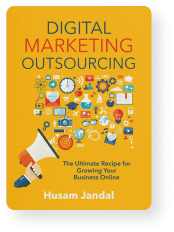 When businesses feel ready to grow, they naturally turn to digital marketing channels. Particularly when you leverage a proven strategy, such as the Digital Marketing Tree, you can gain a lot of ground quickly. However, this is just one of the levers you can pull, and it becomes even more powerful when you pair it with strategies that create growth through partnerships and innovation. Give me a few moments, and I’ll walk you through how to fold this into your marketing mix to amplify your results.
When businesses feel ready to grow, they naturally turn to digital marketing channels. Particularly when you leverage a proven strategy, such as the Digital Marketing Tree, you can gain a lot of ground quickly. However, this is just one of the levers you can pull, and it becomes even more powerful when you pair it with strategies that create growth through partnerships and innovation. Give me a few moments, and I’ll walk you through how to fold this into your marketing mix to amplify your results.
Product-Led Growth Strategy
Product-led growth (PLG) uses your product as the primary engine for acquisition, conversion, and expansion. Users discover value through self-serve trials or freemium options, upgrade when usage becomes essential, and expand across teams. Think of it as an always-on, low-friction path that complements other strategies. While PLG can apply to both existing and new products, a fresh release can boost awareness for all your offerings and breathe new life into your brand.
Product-Led Growth Examples
- Slack’s Bottom-Up Engine: Self-serve free and paid plans, deep integrations, and heavy weekly engagement accelerated “land and expand.” At listing, Slack reported more than ten million daily active users, more than 88,000 paid customers, and a net dollar retention rate of 143 percent, according to the company’s filings.
- Stripe’s Developer-First Motion: Self-serve onboarding and modular products power scale. Its Billing platform, for example, is used by more than 300,000 companies and manages nearly 200 million active subscriptions, the company notes.
- Atlassian’s Self-Serve Flywheel: Free cloud plans attract more than 8,000 new customers each quarter through a low-touch funnel, the company reports. Enterprise sales then focus on larger expansions, and the company recently noted a record number of million-dollar deals, while keeping sales and marketing spend near 15 percent of revenue.
Benefits of Product-Led Growth Strategies
- Lower Cost to Acquire and Expand: Self-serve trials reduce heavy sales time. Marketing and sales then focus on higher-value expansions and renewals.
- Higher Net Revenue Retention: As customers adopt more features and seats, revenue grows within the account, and renewals strengthen.
- Better Signal for Sales Prioritization: Real product usage highlights who is ready now, so teams act faster and waste less motion.
How to Integrate Product-Led Growth into Your Digital Marketing Strategy

- Position in Your Mix: Run product-led growth as the always-on lane beside paid advertising and SEO. Map your content and lifecycle journeys to product milestones so marketing accelerates activation, adoption, and expansion.
- Orchestrate Signals: Send key product events like activation, feature use, and team invites into your customer relationship management (CRM) system and your marketing automation platform. Route high-intent accounts to sales for expansion.
- Create Frictionless First Value: Cut steps to first value with in-app checklists, sample data, and a few prebuilt integrations that reflect core workflows for your buyer.
Tips for Getting Started with a Product-Led Strategy
- Define a Conversion Signal: Pick the one action that best predicts conversion, such as creating a first invoice or connecting a data source, and alert your team when it happens.
- Measure Early Milestones: Track time to first value, activation rate, and invite rate. Use these to guide your onboarding experiments.
- Offer a Safe Starter Path: Provide a limited free or starter plan, or a sandbox, that showcases core workflows for your primary buyer.
- Align Content to In-App Steps: Publish short, job-to-be-done guides that match the exact steps a new user takes.
- Prioritize Essential Integrations: Start with one or two integrations your customers expect, and add more as adoption grows.
- Pilot a Product-Led Sales Pod: Assign a small team to work product-qualified accounts and measure results over one to two quarters.
Pitfalls to Avoid in Product-Led Marketing
- Freemium without Activation: Design a guided setup with a clear first task and an invite prompt, then measure completion rates.
- Missing Data Plumbing: Connect your product events to your customer CRM and your marketing automation platform so sales and marketing can act on usage intent.
- Treating PLG as a Silo: Set shared goals across product, marketing, and sales, such as activation rate and expansion revenue, and review them in one weekly forum.
- Overgeneralized Onboarding: Tailor onboarding to the top two or three jobs your buyers care about, and test messages against those jobs.
Partnership-Driven Growth Strategy
Partnership-driven growth uses other companies or professionals to extend your reach, credibility, and distribution. The right partners bring you into active buying cycles, make it easier for customers to say yes, and open expansion paths after the first win.
Partnership-Driven Growth Examples
- Microsoft’s Partner-Led Revenue: Partners, such as independent software vendors, device partners, and Systems Integrators, influence more than 95 percent of Microsoft’s commercial revenue, the company reports. This type of scaled ecosystem has a major impact on the health of the company,
- Salesforce’s AppExchange Adoption: More than 91 percent of Salesforce customers have installed at least one AppExchange app, per internal reports. In this case, partner solutions become part of the core experience.
Benefits of Partnership-Driven Growth Strategies
- Lower Cost to Acquire Customers: Partners bring warm demand and shorten evaluation.
- Faster Time to Trust: Borrowed credibility helps you clear security and procurement reviews sooner.
- Higher Deal Velocity: Ready integrations and references make buying easier.
- Stronger Expansion Paths: Bundled solutions open cross-sell and upsell after the first win.
How to Integrate Partnership-Driven Growth into Your Digital Marketing Strategy
- Map Partners to Your Ideal Customers: Choose partners who already sell to your buyers and verticals. Build joint pages for those exact use cases.
- Build Findability in Marketplaces: Treat listings like landing pages with a clear offer, case studies, security details, and a short demo.
- Run Joint Campaigns with Clear Tracking: Use shared UTMs and a simple lead-routing plan in CRM so both teams see impact.
- Align Sales Motions: Define when a partner leads, when you co-sell, and when your team takes point. Give reps one concise brief.
- Track Hand-Offs in CRM: Record sourced, influenced, and co-sell opportunities so you can double down on what works.
Tips for Getting Started with a Partnership-Driven Strategy
- Define the Partnership Type: Start with one type, such as referral, reseller, technology integration, or marketplace.
- Choose One Focus Area: Select a single vertical use case with one partner who already has traction. Win three to five reference customers, then expand.
- Create a Joint Offer: Bundle a simple implementation or success plan that reduces risk for the buyer.
- Make it Easy to Pitch: Give partner sellers assets such as a one-page overview, a three-slide mini deck, and a two-minute demo video.
- Set Quarterly Targets: Agree on sourced pipeline, meetings, and wins. Review every two weeks and adjust.
Pitfalls to Avoid in Partnership-Driven Marketing
- Vague Partner Fit: Use a short checklist for customer overlap, product fit, and executive commitment before you sign.
- No Clear Owner: Assign one partner manager with goals tied to the pipeline and revenue.
- One-Sided Value: Ensure both sides see real revenue potential and a path to joint wins.
- Messy Lead Routing: Decide who registers deals and how conflicts are resolved before campaigns go live.
- Underpowered Enablement: Test materials with a few partner reps. If they stumble, tighten the message and try again.
Collaboration-Based Growth Strategy

Collaboration-based growth uses short, focused projects with other companies to create attention, test new offers, or speed adoption without a long-term contract. Consider pilots, limited co-built features, co-hosted events, or co-created content that support your pipeline now.
Co-Branded Collaboration Examples
- Edelman-LinkedIn B2B Thought Leadership Impact Reports: The PR firm and professional networking platform come together annually to better understand how thought leadership affects pipeline and sales outcomes.
- Doritos Locos Tacos from Taco Bell: Consumer brands mix and match all the time to generate excitement and reach new audiences. This collab proved to be a massive success for both brands.
Benefits of Collaboration-Based Growth Strategies
- Faster Proof with Less Risk: You validate demand or usability before a big commitment.
- Fresh Reach and Credibility: You show up in another company’s channels and ride the attention of a joint announcement.
- Quicker Content and PR Hooks: A limited launch or pilot gives you a specific story that marketing can amplify now.
- Clear Go or No-Go Moment: You decide to scale, revise, or stop based on defined results.
How to Integrate Collaboration-Based Growth into Your Digital Marketing Strategy
- Set One Success Metric: Pick a single outcome, such as qualified demos booked or pilot conversions, and report on it weekly.
- Build a Joint Page and Demo: Publish a short page and a two-minute demo that explains the problem, what you built together, and the call to action.
- Run a Focused Launch: Announce with one webinar, one customer story, and a short press note. Keep the calendar tight so momentum is visible.
- Track Sourced and Influenced Deals in CRM: Create a campaign tag so you can attribute pipeline to the collaboration and decide quickly on next steps.
- Capture Lessons for Product and Sales: Feed what buyers asked for back into messaging, pricing, and roadmap.
Tips for Getting Started with a Collaboration-Based Strategy
- Choose One Focus Area: Pick one use case you both hear from customers, and define a small, meaningful scope.
- Confirm Owners on Both Sides: Name an executive sponsor and a day-to-day lead at each company so decisions do not stall.
- Write a One-Page Working Plan: List roles, deliverables, dates, review steps, and who owns support during the pilot.
- Pilot with Three to Five Customers: Get fast feedback, adjust, and collect a short quote you can use in marketing.
- Plan the Exit or Scale Path: Decide what happens if it works, and what you will do if it does not.
Pitfalls to Avoid in Collaboration-Based Marketing
- Fuzzy Problem and Audience: Start with a plain statement of the customer problem and two or three user stories.
- Too Many Moving Parts: Keep scope small. One use case, one page, one demo, one event.
- Slow Reviews: Involve legal, security, and brand early with a checklist and deadlines.
- No Post-Launch Ownership: Assign who handles questions, renewals, and next steps before you launch.
Get Help Creating Growth Through Partnerships and Innovation
Even when you understand the philosophies behind these strategies, identifying which path to take and how to make it happen in a cost-effective way that delivers a return can be challenging. However, these are the types of tactics I weave into successful digital marketing strategies for my clients every day. If you’d like to explore your options, let’s talk.
FAQs on Creating Strategic Business Growth Through Partnerships and Innovation
When should a company prioritize a partnership over a new product?
Choose a partnership when speed, credibility, or capability gaps matter more than owning the whole solution. If customers already buy from a trusted provider, a partner launch lets you validate demand, reduce risk, and reach the market sooner while you learn what to build or where to invest next.
How long should a pilot run before a scale decision?
Aim for six to 12 weeks or one to two sales cycles. Define one success metric, target accounts, and exit criteria up front. A good pilot reaches enough customers to be confident, costs little to run, and ends with a simple go, revise, or stop decision backed by data.
What metrics signal that a collaboration is working?
Track sourced pipeline, influenced revenue, meeting volume, and conversion rate lift. Measure sales cycle time, product activation or usage by pilot customers, and early retention. Watch cost to acquire and cost to deliver. If velocity improves and unit economics hold, you are ready to scale or extend the effort.
Why is collaboration important in business strategy?
Collaboration gives you speed, reach, and credibility. You combine strengths to solve a clear customer problem, share costs and risk, and test demand before deeper investment. Well-run collaborations create proof points your teams can market and sell, while informing what to build, price, and partner on next.
Can you grow a company without marketing?
You can grow for a while through founder selling, referrals, and product momentum. Growth is faster and more resilient when marketing shapes positioning, creates demand, and scales education across channels. Even a lightweight marketing motion helps you reach new buyers, shorten sales cycles, and improve retention over time.
What types of partnerships lead to scalable growth?
Reseller and channel programs expand distribution. Marketplace listings improve findability and reduce procurement friction. Technology integrations that solve a shared workflow increase adoption. Co-selling alliances align sales teams around target accounts. Original equipment manufacturer (OEM) partnerships embed your product inside another product, creating recurring, high-margin revenue at scale.
How do you identify good collaboration opportunities?
Start with a real customer problem that both companies hear often. Confirm audience overlap, a clear combined advantage, and a small scope that can ship quickly. Secure an executive sponsor and a day-to-day owner on each side. Define one success metric and a short plan to measure results.
What are real-world examples of successful co-branded partnerships?
Intel and leading PC makers built “Intel Inside” to signal performance and trust. Apple and IBM launched MobileFirst for Business to co-market enterprise apps and services. Microsoft and Adobe aligned customer experience solutions on Azure with a joint go-to-market strategy. Each combines brand, distribution, and credibility to win enterprise buyers.
How do new products contribute to long-term growth?
New products open fresh revenue streams, increase average deal size, and create expansion paths inside existing accounts. They strengthen pricing power, reduce churn by deepening value, and diversify your portfolio across segments or use cases. A steady release cadence compounds visibility, partner interest, and customer lifetime value.
How can startups use partnerships to expand faster?
Pick one partner that already sells to your ideal customers. Build a simple joint offer, list it in their marketplace if available, and agree on lead routing in CRM. Co-host one webinar and one customer story. Measure sourced pipeline, win rate, and time to close. Expand only when results prove out.
What is the difference between marketing-led and partnership-led growth?
Marketing-led growth creates demand through your channels, such as content, search, events, and advertising. Partnership-led growth creates demand through another company’s channels and sellers, such as resellers, marketplaces, or co-selling. The strongest plans combine both, so marketing primes demand and partnerships accelerate access and trust inside accounts.
How do you align product, marketing, and partnerships in one strategy?
Set one growth goal and a few shared metrics, such as activation, qualified pipeline, and expansion revenue. Build a single quarterly plan. Connect product usage signals to CRM so marketing and partner sellers see intent. Review performance together every two weeks and reallocate effort to what is working.
What are the risks of relying only on marketing for growth?
Channels saturate, costs rise, and platform changes can stall momentum. Without product, partnership, and sales alignment, you see lower conversion and weaker retention. A balanced plan reduces risk by adding distribution through partners, deeper value through product, and clearer targets for sales. Diversification safeguards compounding growth.
How do you evaluate if a new product or partnership will drive growth?
Write a short business case. Define the target customer, problem, and clear advantage. Size the opportunity and set one success metric. Outline the pilot scope, required resources, and risks. Decide how it reaches customers, how you will sell it, and what it replaces. Run a small test, then decide.





































































